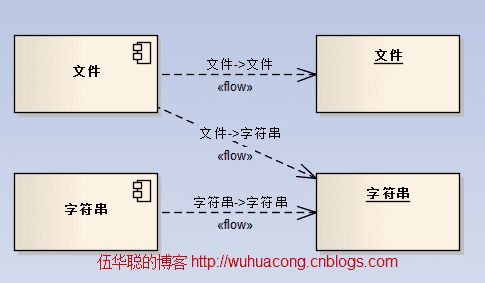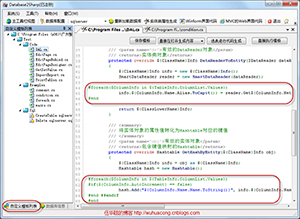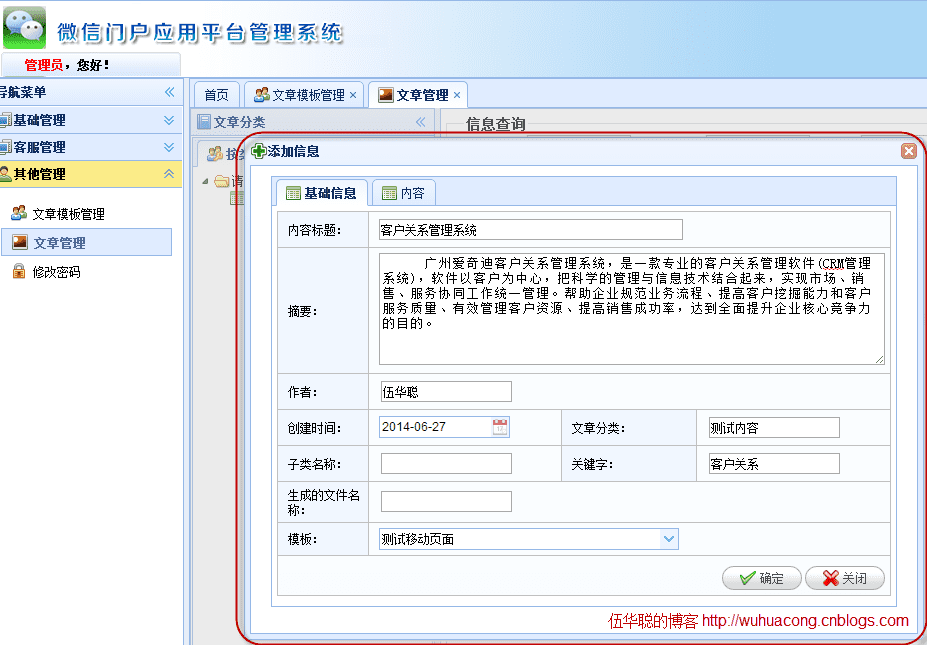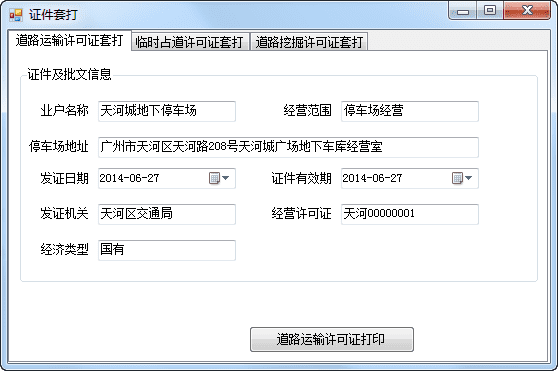基于NVelocity的几种内容生成方式有什么?
基于NVelocity的几种内容生成方式有什么?
使用NVelocity也有几个年头了,主要是在我的代码生成工具Database2Sharp上使用来生成相关代码的,不过NVelocity是一个非常不错的模板引擎,可以用来生成文件、页面等相关处理,非常高效和方便。
它原先是在网站http://nvelocity.sourceforge.net/ 上维护,不过从0.41后,该网站就不再进行NVelocity更新了,现在可以在网站http://nvelocity.codeplex.com/上获得最新版本的更新,接着版本的更新操作,我们把NVelocity的几种生成文件的操作介绍一下,以便大家进行更深入的了解。
1、基于NVelocity的几种内容生成方式

从上面的图示,我们可以看到,NVelocity的模板化生成包含了3种方式,一种是从文件到文件或者字符串,一种是从字符串到字符串,他们各自的处理方式有所不同,但是都能正确解析里面的内容。
为了更好利用NVelocity的特性,我们对它进行一个初步的辅助类封装。
/// <summary>
/// 基于NVelocity的模板文件生成辅助类
/// </summary>
public class NVelocityHelper
{
protected VelocityContext context;
protected Template template;
protected string templateFile;
/// <summary>
/// 存放键值的字典内容
/// </summary>
private Dictionary<string, object> KeyObjDict = new Dictionary<string, object>();
/// <summary>
/// 添加一个键值对象
/// </summary>
/// <param name="key">键,不可重复</param>
/// <param name="value">值</param>
/// <returns></returns>
public NVelocityHelper AddKeyValue(string key, object value)
{
if (!KeyObjDict.ContainsKey(key))
{
KeyObjDict.Add(key, value);
}
return this;
}................
上面的AddKeyValue方法,主要用来为模板引擎添加一些需要绑定在页面上的变量对象,这样页面变量参数的内容就能正确解析出来了。
为了使用NVelocity的各种特性,我们需要在辅助类里面构造模板的相关信息,设置相关参数。
/// <summary>
/// 初始化模板引擎
/// </summary>
protected virtual void InitTemplateEngine()
{
try
{
//Velocity.Init(NVELOCITY_PROPERTY);
VelocityEngine templateEngine = new VelocityEngine();
templateEngine.SetProperty(RuntimeConstants.RESOURCE_LOADER, "file");
templateEngine.SetProperty(RuntimeConstants.INPUT_ENCODING, "utf-8");
templateEngine.SetProperty(RuntimeConstants.OUTPUT_ENCODING, "utf-8");
//如果设置了FILE_RESOURCE_LOADER_PATH属性,那么模板文件的基础路径就是基于这个设置的目录,否则默认当前运行目录
templateEngine.SetProperty(RuntimeConstants.FILE_RESOURCE_LOADER_PATH, AppDomain.CurrentDomain.BaseDirectory);
templateEngine.Init();
template = templateEngine.GetTemplate(templateFile);
}
catch (ResourceNotFoundException re)
{
string error = string.Format("Cannot find template " + templateFile);
LogTextHelper.Error(error);
throw new Exception(error, re);
}
catch (ParseErrorException pee)
{
string error = string.Format("Syntax error in template " + templateFile + ":" + pee.StackTrace);
LogTextHelper.Error(error);
throw new Exception(error, pee);
}
}
在生成内容之前,需要把相关的对象属性绑定到模板引擎的上下文对象里面。
/// <summary>
/// 初始化上下文的内容
/// </summary>
private void InitContext()
{
context = new VelocityContext();
foreach (string key in KeyObjDict.Keys)
{
context.Put(key, KeyObjDict[key]);
}
}
1)根据模板文件构造对应的文件内容
/// <summary>
///根据模板创建输出的文件,并返回生成的文件路径
/// </summary>
public virtual string ExecuteFile()
{
string fileName = "";
if (template != null)
{
string filePath = CheckEndBySlash(directoryOfOutput);
fileName = filePath + fileNameOfOutput + fileExtension;
if (!string.IsNullOrEmpty(filePath) && !Directory.Exists(filePath))
{
Directory.CreateDirectory(filePath);
}
//LogTextHelper.Debug(string.Format("Class file output path:{0}", fileName));
InitContext();
using (StreamWriter writer = new StreamWriter(fileName, false))
{
template.Merge(context, writer);
}
}
return fileName;
}
2)根据模板文件构造字符串内容
/// <summary>
/// 根据模板输出字符串内容
/// </summary>
/// <param name="templateFile"></param>
/// <returns></returns>
public string ExecuteString()
{
InitContext();
System.IO.StringWriter writer = new System.IO.StringWriter();
template.Merge(context, writer);
return writer.GetStringBuilder().ToString();
}
3)根据字符串内容构造字符串输出
/// <summary>
/// 合并字符串的内容
/// </summary>
/// <returns></returns>
public string ExecuteMergeString(string inputString)
{
VelocityEngine templateEngine = new VelocityEngine();
templateEngine.Init();
InitContext();
System.IO.StringWriter writer = new System.IO.StringWriter();
templateEngine.Evaluate(context, writer, "mystring", inputString);
return writer.GetStringBuilder().ToString();
}
上面几种操作模板输出的方式,其调用代码如下所示。
private void btnGenerateFile_Click(object sender, EventArgs e)
{
string tempalte = "Template/template.htm";//相对目录
TestInfo info = new TestInfo();
info.Title = "测试标题";
info.Content = "测试内容,这是测试内容";
info.Datetime = DateTime.Now;
NVelocityHelper adapter = new NVelocityHelper(tempalte);
adapter.AddKeyValue("title", "This is a title")
.AddKeyValue("content", "This is a Content")
.AddKeyValue("datetime", System.DateTime.Now)
.AddKeyValue("TestInfo", info);
adapter.FileNameOfOutput = "testTemplate";
string filePath = adapter.ExecuteFile();
if (!string.IsNullOrEmpty(filePath))
{
Process.Start(filePath);
}
}
private void btnGenerate_Click(object sender, EventArgs e)
{
string tempalte = "Template/template.htm";//相对目录
TestInfo info = new TestInfo();
info.Title = "测试标题";
info.Content = "测试内容,这是测试内容";
info.Datetime = DateTime.Now;
NVelocityHelper adapter = new NVelocityHelper(tempalte);
adapter.AddKeyValue("title", "This is a title")
.AddKeyValue("content", "This is a Content")
.AddKeyValue("datetime", System.DateTime.Now)
.AddKeyValue("TestInfo", info);
this.txtCode.Text = adapter.ExecuteString();
}
private void btnMergeString_Click(object sender, EventArgs e)
{
System.Text.StringBuilder builder = new System.Text.StringBuilder();
builder.Append(
"${Title}\r\n" +
"$Content\r\n" +
"$Digest\r\n" +
"$Author\r\n" +
"$Keyword\r\n" +
"$DateTime\r\n");
NVelocityHelper adapter = new NVelocityHelper();
adapter.AddKeyValue("Title", "标题").
AddKeyValue("Content", "内容").
AddKeyValue("Digest", "摘要").
AddKeyValue("Author", "作者").
AddKeyValue("Keyword", "关键词").
AddKeyValue("DateTime", DateTime.Now);
this.txtCode.Text = adapter.ExecuteMergeString(builder.ToString());
}
2、模板引擎NVelocity的几种应用场景
上面的几种操作模板内容的方式,能够在绝大多数情况下满足我们的应用要求,如可以在代码生成工具里面,定义一些自定义的内容模板,然后结合数据库的元数据信息,实现丰富逻辑的代码生成操作。

也可以在一些内容管理的应用上(如文章管理方面),根据输入的内容,实现文章内容的文件生成操作,这个生成后,我们就直接使用文章的文件链接地址就可以了。

或者根据数据信息生成具体的页面,用于套打操作,如下是Winform里面的套打处理。


以上所述是小编给大家介绍的基于基于NVelocity的几种内容生成方式汇总,希望对大家有所帮助,如果大家有任何疑问请给我留言,小编会及时回复大家的。在此也非常感谢大家对路饭网站的支持!